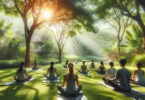Guest Writers for Wake Up World
Summer is officially here! Pools are opening, schools are letting out, and the backyard BBQ has returned. If there ever was a time to get up, get going and GET OUTSIDE, this would be it! What are you doing this season to celebrate the warmer days, longer periods of sunshine, and precious family time together?
Consider this your wake-up call from a loving friend (i.e., me). Get off that couch, put on some comfy clothes and that sun hat, and welcome the day! The following 5 activities can help you do that as well as boost your immune system, lift your mood, and help fight cancer.
1 | Swimming
First, let’s take a look at an activity that is synonymous with summer fun….swimming! Whether it is at the local pool, the lake, or the beach, swimming has been shown to contribute to some pretty amazing mechanisms that can help your health.
To better understand the benefits of swimming, we need to understand the importance of sleep. There is a direct correlation between sleep issues and cancer. Not enough sleep has also been associated with cell damage, shortened telomere length, lower immunity, and accelerated aging. And according to a 2014 study published in the journal Cancer Research, “fragmented sleep” has direct correlations with the acceleration of tumor growth.
Swimming, on the other hand, has been found to actually help individuals sleep deeper and longer. Studies such as a 2010 investigation at Northwestern University on sedentary adults who had insomnia found that exercising regularly, including swimming, helped them to sleep through the night.
One of the reasons why swimming may be so beneficial for sleep habits is because of how it can regulate blood sugar levels. A 2016 trial conducted at the University of Copenhagen in Denmark found that premenopausal women who were able to swim three times a week for one hour had improved glucose regulation as well as heightened insulin sensitivity.
Insulin is a key hormone in the body. When it is off-balance, this can affect other hormones, including melatonin, which is necessary for maintaining circadian rhythms and proper sleep cycles. Interestingly, the Copenhagen study found that low-intensity swimming was actually more effective for maintaining glucose levels than high-intensity aerobic activity.
Swimming is also an excellent option for older people and those with stiff joints or arthritic conditions.
“Unlike [with] land-based sports, swimmers are required to create their own base of support and at the same time, to produce a coordinated movement of both upper and lower extremities,” said Dr. Dafna Merom in a recent interview for LiveScience.
Merom and her team at the University of Western Sydney in Australia analyzed the exercise habits of over 1,500 men over 70. They found that the actions involved in swimming helped with joint flexibility and bone strength. In the study, the men who swam on a regular basis were 33% less likely to suffer a fall than other men who did not swim.
And here is a quick tip for those who prefer to swim in a pool versus the great outdoors. The best bet to avoid the toxic consequences of chemicals put in pool water, especially chlorine and bromide, is to find a saltwater pool to do laps or exercise in. Many gyms, rec centers, and even hotels are opting for salt water these days, so be sure to call around in your area to find one near you!
2 | Biking
There is nothing like feeling the breeze on your face as you bike along a wooded path or a boardwalk along the seashore. That is why a recent survey found that 12% of the United States population bike on a regular basis.
Biking can boost your mood, kick out lethargy, lift depression, calm anxiety, and help your concentration levels. Biking is also really good for your physical health, especially for building both leg and core strength.
Your “core” is defined as the muscles in your back as well as in your abdominals. Developing these areas through biking can improve balance and coordination. In addition, building fortitude in the abs can prevent “anterior tilt” of the pelvis. According to a 2011 UK study, roughly 85 percent of adults have this condition brought on by sitting and a sedentary lifestyle. However, most do not even know that they have it. Pelvic tilt can lead to lower back pain, ruptured discs, and more serious conditions such as Facet Joint Syndrome, which is inflammation and stiffness of the tissues between the joints in the spine.
Remember that your spine is where your vagus nerve is located, which is the main thoroughfare of both motor and sensory communication between the brain and the major organs. Vagus nerve health is intricately connected to heart health, temperature regulation, digestive health, cognition, and more. A 2018 study sponsored in part by Stanford University and published in the Journal of Oncology found that “vagus nerve activation” plays a protective role against cancer tumor growth and especially against metastasis. That means that a healthy vagus nerve can protect you against cancer!
Finally, studies have found that biking is actually one of the most ideal sports for those who are recovering from cancer. According to a 2019 study conducted at the University of Texas MD Anderson Cancer Center in Houston, Texas, biking helped women recovering from breast cancer to stay active, prevent fatigue, reduce the side effects of chemotherapy and improve their overall quality of life.
These days there are more bike trails than ever, and not just in Europe! Many U.S. cities are converting their unused median strips into bike trails and their downtown areas into “no car” zones. Apps abound that can tell you where the best in-town and off-road trails are anywhere in the country. According to a report published in Outside magazine, more people are biking now than before the pandemic.
3 | Hiking
If you prefer to “hoof it,” this summer, why not do it with the best scenery and view you can find? Hiking has been around since, well, people started walking upright!
Hiking can be a cancer-fighter on several fronts. Being in nature has been shown in numerous studies to calm stress responses and lower cortisol levels. In turn, lower pulse rate and blood pressure are associated with time in nature.
In studies on the Japanese activity of “Shinrin-Yoku,” which translates into “Forest Bathing” in English, researchers found that inflammation levels in individuals who were simply “being” amongst the trees were considerably lower. Parasympathetic nerve activity also increases, which can boost immune function and digestion.
The specific phytonutrients, called phytocides or wood essential oils, emitted by forest-dwelling trees, in particular, have also been known to have anti-cancer properties.
Now couple these benefits with trekking up steep inclines, maneuvering your footing amongst rocky terrain, and maybe even inching your way across downed trees, and you have a pretty good workout to boot!
According to the National Park Service, hiking is one of the best exercises around. It can help your heart and also improve respiratory function, especially when hiking at a higher elevation.
NPS says hiking can also build “relational health.” This is because it is common (and sometimes recommended for safety reasons) to hike with a designated “hiking buddy.” Hiking together is a great way to get to know someone or to get to know them better! Studies show that maintaining social networks and connections, even with pets (many of whom make great hiking buddies!) can curb feelings of isolation and loneliness and greatly contribute to healing from disease.
4 | Dancing
Speaking of social interaction, dancing can be a GREAT form of exercise that is also highly social. You might not think about dancing as a summer activity. Indeed, there are opportunities to “cut a rug” in any season. Summertime, however, offers many opportunities to tap a foot or swing your partner in the out of doors that other seasons don’t.
First, let’s talk about the benefits of dancing in general. Dance can be a great cardio workout. According to the U.S. Department of Health and Human Services, adults should try to get in at least 150 minutes of cardiovascular activity (also known as aerobic activity) per week. To break it down in a way that can fit into anyone’s routine, that means if you “rock out” (or groove, swing, shuffle, salsa, or shimmy) to about a half dozen of your favorite tunes five days a week, you’ve got it covered!
Dance can do more than just give you a great cardio workout. According to a report put out by Harvard University, rhythmic movement can also lower blood pressure, build muscle and bone, help with coordination, and improve cholesterol levels.
Then there is the sheer joy, celebration, and even emotional release that pretty much everyone feels when they are letting loose and letting go through music and dance. Research sponsored by the National Institutes of Health found that listening to music that one enjoys stimulates the reward centers in the brain. In addition, dancing to that music can activate motor circuits and sensory mechanisms. And if learning a specific dance style is more your thing, research also indicates that learning dance patterns can help with memory and problem-solving abilities.
That is great news at any age, but it is especially important as people get older. A 2018 meta-analysis conducted at the University of Malaga in Spain looked at over two dozen other studies. They made the conclusion that music therapy was a significant and valid non-pharmaceutical modality that can be vastly important for patients with neurological disease such as Parkinson’s.
Now for the fun part. The summer is absolutely the best time of year to get both some outdoor time and some dance time in as well! In small towns, medium-sized cities, and major metropolitan areas, summer is the season for summer concerts, especially in the months of June, July, and August. Many of these events are free and feature danceable beats, local bands, and, in many areas, a big grassy area to kick off your shoes and sway a little.
The summer is also a great time to try something new as a family. So why not try some dance? Try salsa, swing, or line dancing. Give water dance or water aerobics (to your favorite tunes) a go! And don’t forget the June weddings, 4th of July barbecues, and August “get out of town before school starts again” mini-vacations. Those are great times to let loose and cut a rug as well. And if you don’t have an event to go to, why not just kick off your shoes, go out in the backyard with a speaker or your headphones and do some grooving. You will be helping your health and preventing cancer as well.
5 | Walking
Last but not least, there is walking. I know, simply putting one foot in front of the other doesn’t sound nearly as exciting as some of the other activities on this list. Interestingly, though, walking at a good clip is actually an excellent out. That is why it was the activity of choice for the U.S. DHHS for their recommendations cited above.
One of the biggest testaments to the benefits of walking can be found in ‘Blue Zone” communities. These are regions all over the world, discovered by award-winning journalist Dan Buettner and his team of researchers in the early 2000s, that contain the largest number of centenarians, i.e., people who are over 100 years of age.
In every one of these cultures, “natural movement” forms of exercise are a consistent and regular part of their day. Amongst the most common of these is walking.
“The world’s longest-lived people don’t pump iron, run marathons or join gyms,” says Buettner. “Instead, they live in environments that constantly nudge them into moving without thinking about it. They grow gardens and don’t have mechanical conveniences for house and yard work.”
And that means that they walk (or bike) pretty much everywhere!
Summer is the most active season of all. If you think about it, more than likely you are going to have a lot of opportunities to do some walking this summer too, whether it is strolling along the boardwalk with relatives in from out of town, walking across the parking lot to go to that summer concert, or booking it around town on a summer shopping spree.
Another great advantage of walking is that it is so easy. All you need is a pair of tennis shoes or walking sandals. This means that walking can also be a great go-to for those busy summer workdays. Let’s face it, even though your kids are off for the summer, you may still be doing the 9 to 5 at least some of the time! For workdays, a quick walk around the block in the early morning or a brisk evening nature trail jaunt may be just the thing you need to start or end your day. What is so great about summer is that, in most areas of North America, there is plenty of sunlight both in the morning and the evening to fit that half hour in!
My only other advice about walking (besides to just do it!) is to try to walk in as much of a natural setting as possible. Even around your neighborhood if it is quiet and tree-lined or a local park is fine. Studies have found that while walking in a natural setting can lower brain-related disorders such as depression, anxiety, fatigue, confusion, and negative emotional states such as anger, walking in an urban setting appears to have the opposite effect.
Get Up, Get Moving, and Fight Cancer
There is lots to do and to discover in this big, wide world, and also in your own backyard! Right now in the middle of summer is the perfect time to explore it. You can do that and also help your body heal by getting going, getting outside, and getting moving!
About the Author:
Charlene Bollinger is a devoted Christian, happily married wife, joyful mother of 4 beautiful home-educated children, health freedom advocate, and co-founder and CEO of The Truth About Cancer. She is a former model and actress, fitness buff, and lover of healthy food and living. After losing several family members to conventional cancer treatments, Charlene and Ty learned the truth about cancer and the cancer industry, working together tirelessly to help others to learn the truth that sets them free to live healthy, happy lives. Charlene speaks at many conferences and is a guest on various health-related radio shows helping people discover that cancer does NOT have to be a death sentence. Together, they host a biweekly internet news program: TTAC Global Health News.
For more information, visit:

If you've found value in our articles, we invite you to support the release of our brand-new book, "Gratitude Practices for Kids: A Practical Guide for Adults to Instill a Spirit of Appreciation and Positivity in the Next Generation."
"Gratitude Practices for Kids" brings together over 25 innovative and accessible practices designed to enhance gratitude in everyday life. This comprehensive guide is backed by 17 scientific studies, ensuring each concept is grounded in research, underscoring our commitment to nurturing growth, emotional intelligence, and positive interactions between adults and children.
We encourage you to opt for the paperback version to celebrate this new release. Dive into its fresh pages away from digital distractions, allowing you to immerse yourself in the transformative practices it offers.
Over recent years, Wake Up World has faced significant online censorship, which has impacted our financial ability to operate. Moving into book publishing represents a strategic step to secure the ongoing funds needed to continue our mission. By purchasing Gratitude for Kids, you help us keep our content free and accessible to everyone, avoiding needing a paywall. With over 8,500 articles published in the last 13 years, we remain dedicated to keeping our valuable content open to all.









